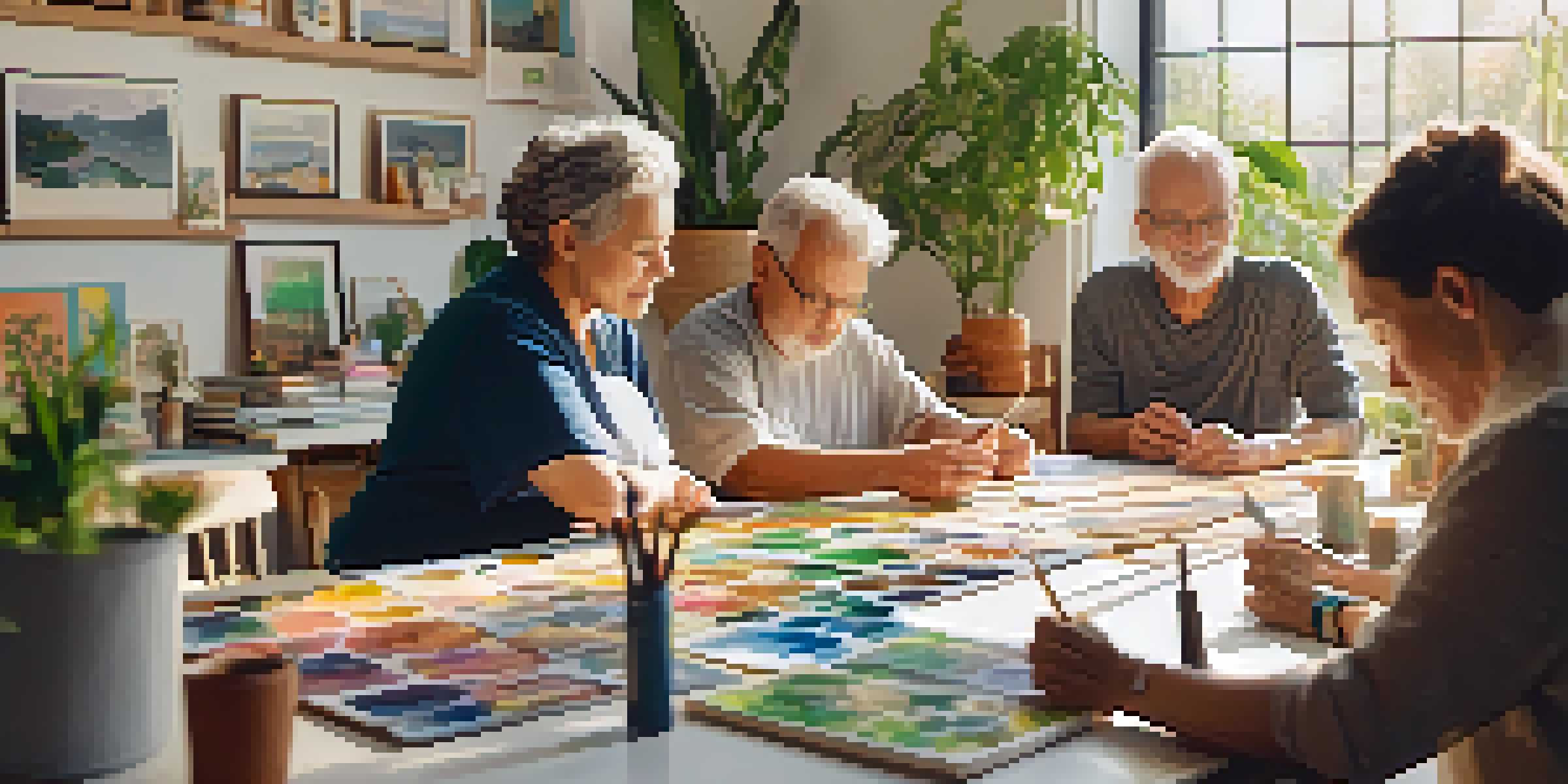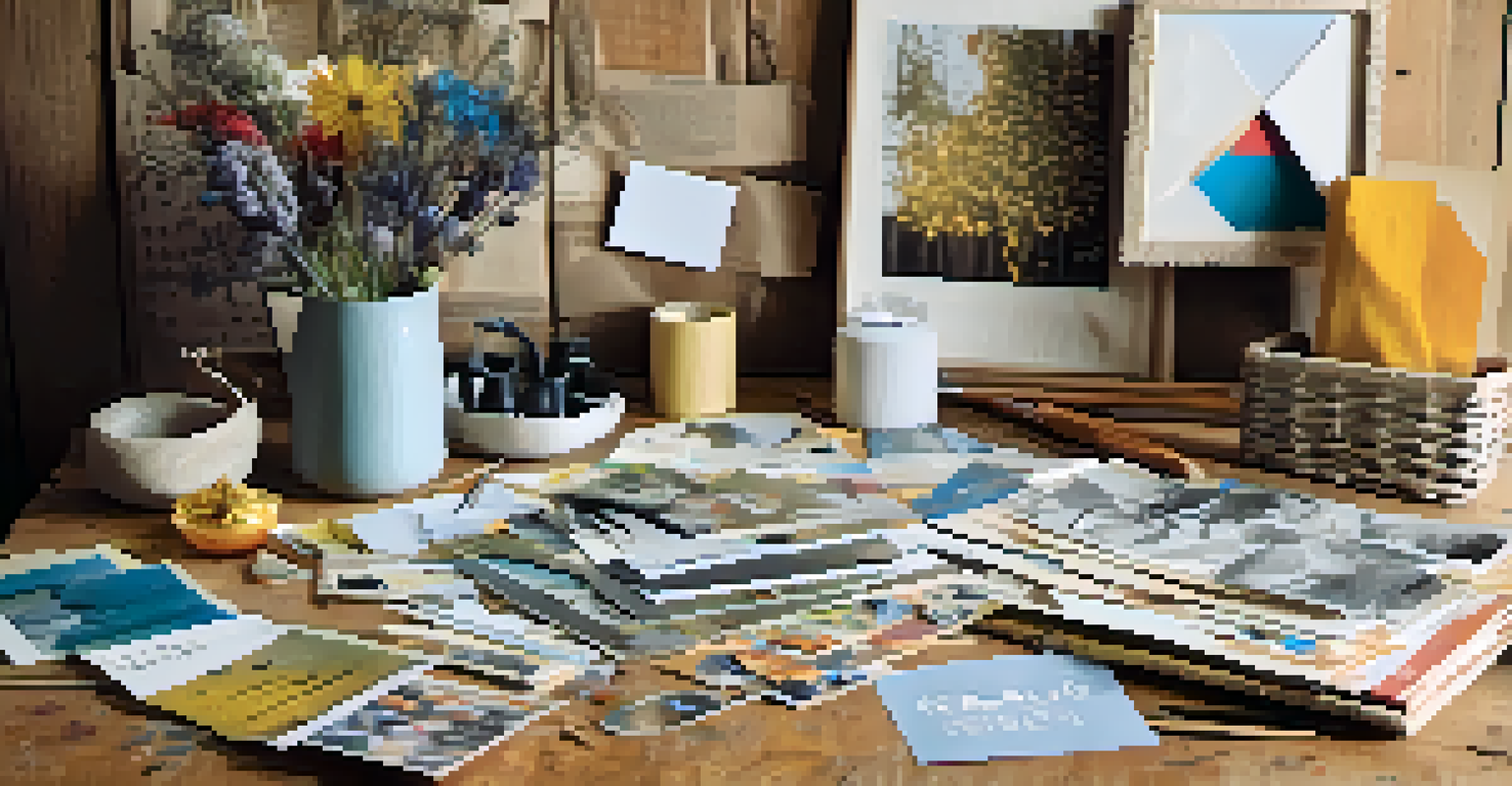Integrating Art Therapy into Addiction Recovery Programs

Understanding Art Therapy in Addiction Recovery
Art therapy combines creative expression with psychological healing, making it a powerful tool in addiction recovery. This therapeutic approach allows individuals to explore their emotions, experiences, and challenges through art forms like painting, drawing, or sculpture. By engaging in creative activities, participants can articulate feelings that may be difficult to express verbally, creating a unique pathway to healing.
Art is not what you see, but what you make others see.
Research has shown that art therapy can reduce anxiety and depression, common co-occurring issues among those in recovery. The creative process encourages mindfulness and self-reflection, helping individuals to reconnect with their inner selves. As they create, they often find clarity and insight that can be pivotal in their recovery journey.
Importantly, art therapy is not about the final product but the process of creation itself. This focus on expression rather than judgment allows participants to explore their struggles in a safe environment. For many, this can be a liberating experience, fostering a sense of accomplishment and boosting self-esteem.
Benefits of Incorporating Art Therapy
Integrating art therapy into addiction recovery programs offers numerous benefits. One significant advantage is its ability to promote emotional expression without the pressure of traditional talk therapy. For those who find it hard to open up, art provides an alternative means to communicate feelings and experiences, leading to deeper insights.

Additionally, art therapy can enhance social connections among participants. Group art sessions allow individuals to bond over shared experiences, fostering a sense of community and support. This connection can be crucial in recovery, as it helps combat feelings of isolation that often accompany addiction.
Art Therapy Enhances Emotional Healing
Art therapy offers a unique avenue for individuals in addiction recovery to express emotions and experiences creatively, promoting psychological healing.
Moreover, engaging in artistic activities can serve as a healthy coping mechanism. Participants learn to channel their emotions into creativity rather than substance use, which can lead to more sustainable recovery outcomes. This shift in coping strategies is essential for long-term healing.
How Art Therapy Complements Traditional Approaches
Art therapy doesn't replace traditional addiction treatment methods; instead, it complements them beautifully. While therapies like cognitive-behavioral therapy (CBT) focus on changing thought patterns, art therapy allows individuals to explore and express their emotions. This holistic approach addresses both the mind and the heart, creating a more balanced recovery experience.
Creativity takes courage.
Furthermore, art therapy can help in processing trauma that often underlies addictive behaviors. Many individuals in recovery have experienced significant trauma, and art can be a safe outlet for those feelings. By incorporating art therapy, programs can provide a more comprehensive treatment plan that addresses all aspects of a person's well-being.
Integrating these approaches can also improve engagement in therapy. When individuals find joy in creating art, they may be more inclined to attend sessions and actively participate in their recovery. This increased engagement can lead to better outcomes and a more fulfilling recovery journey.
The Role of the Art Therapist
Art therapists are trained professionals who play a crucial role in this therapeutic process. They are equipped not only with artistic skills but also with knowledge in psychology and addiction treatment. This unique combination allows them to guide participants in exploring their emotions through art while ensuring a safe and supportive environment.
A skilled art therapist tailors the therapeutic activities to meet the individual needs of each participant. They facilitate discussions about the created artworks, helping individuals to process their emotions and experiences. By doing so, they can assist participants in making connections between their artwork and their recovery journey.
Community and Connection Through Art
Participating in group art therapy fosters social bonds among individuals, helping to combat isolation and build support networks crucial for recovery.
Moreover, art therapists can collaborate with other professionals in addiction recovery programs, ensuring a holistic treatment approach. Their insights can contribute to the overall understanding of a participant's progress, allowing for adjustments in treatment plans as necessary.
Types of Art Therapy Techniques Used
There are various art therapy techniques utilized in addiction recovery settings. One popular method is guided imagery, where participants visualize scenes or emotions and then create art based on those experiences. This technique encourages deep emotional exploration, allowing individuals to confront and express feelings that might otherwise remain hidden.
Another effective technique is collage-making, which encourages participants to piece together images that resonate with their experiences and recovery goals. This hands-on activity fosters creativity and can spark meaningful discussions about the individual's journey. Collages can serve as visual representations of hope, healing, and transformation.
Additionally, expressive art activities such as painting or clay modeling provide participants with an outlet for their emotions. These techniques are often spontaneous, allowing individuals to express themselves freely without pressure. The result is a process that can be both therapeutic and enjoyable, reinforcing the idea that recovery can be a positive experience.
Challenges of Integrating Art Therapy
While the benefits of art therapy in addiction recovery are clear, there are challenges to consider when integrating it into programs. One significant hurdle is the need for trained art therapists who understand both art and addiction. Finding professionals who are equipped to handle the complexities of recovery can sometimes be a barrier for programs.
Another challenge is the perception of art therapy itself. Some individuals may view it as a less legitimate form of treatment compared to traditional methods. Educating both participants and professionals about the value and effectiveness of art therapy is essential to overcoming these misconceptions.
Art Therapy Complements Traditional Treatment
Integrating art therapy with conventional addiction treatments creates a holistic approach that addresses both emotional expression and cognitive behavioral patterns.
Additionally, funding can be a concern for many recovery programs. Integrating art therapy may require additional resources, such as materials and hiring qualified staff. Programs must find ways to secure funding or allocate resources to ensure that art therapy can be a sustainable part of their offerings.
Success Stories: Art Therapy in Action
Many individuals have found success through the integration of art therapy in their recovery journeys. For example, a young woman struggling with substance use found that painting allowed her to express feelings of anger and sadness she had suppressed for years. Through her art, she began to process her trauma, leading to significant breakthroughs in her recovery.
Another inspiring story involves a group of veterans in recovery who used collage-making to share their experiences. By creating visual narratives of their lives, they built connections with one another and found a supportive community. This shared experience not only fostered healing but also reduced feelings of isolation and stigma.

These success stories highlight the transformative power of art therapy. They show that when individuals are given the tools to explore their emotions creatively, they can find hope, healing, and a renewed sense of purpose in their recovery journey.